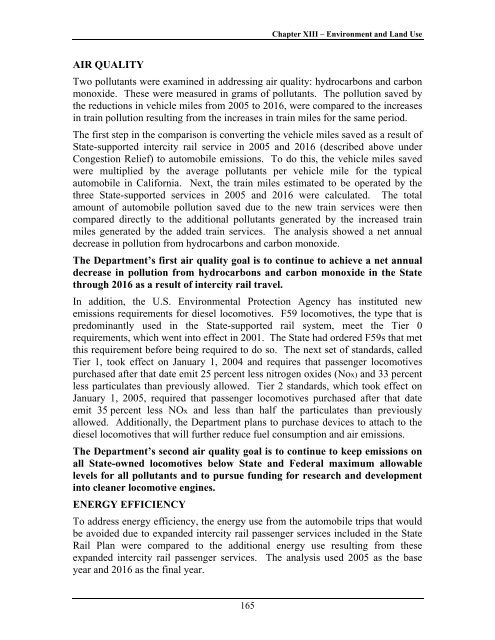California State Rail Plan 2005-06 to 2015-16
California State Rail Plan 2005-06 to 2015-16
California State Rail Plan 2005-06 to 2015-16
Create successful ePaper yourself
Turn your PDF publications into a flip-book with our unique Google optimized e-Paper software.
Chapter XIII – Environment and Land Use<br />
AIR QUALITY<br />
Two pollutants were examined in addressing air quality: hydrocarbons and carbon<br />
monoxide. These were measured in grams of pollutants. The pollution saved by<br />
the reductions in vehicle miles from <strong>2005</strong> <strong>to</strong> 20<strong>16</strong>, were compared <strong>to</strong> the increases<br />
in train pollution resulting from the increases in train miles for the same period.<br />
The first step in the comparison is converting the vehicle miles saved as a result of<br />
<strong>State</strong>-supported intercity rail service in <strong>2005</strong> and 20<strong>16</strong> (described above under<br />
Congestion Relief) <strong>to</strong> au<strong>to</strong>mobile emissions. To do this, the vehicle miles saved<br />
were multiplied by the average pollutants per vehicle mile for the typical<br />
au<strong>to</strong>mobile in <strong>California</strong>. Next, the train miles estimated <strong>to</strong> be operated by the<br />
three <strong>State</strong>-supported services in <strong>2005</strong> and 20<strong>16</strong> were calculated. The <strong>to</strong>tal<br />
amount of au<strong>to</strong>mobile pollution saved due <strong>to</strong> the new train services were then<br />
compared directly <strong>to</strong> the additional pollutants generated by the increased train<br />
miles generated by the added train services. The analysis showed a net annual<br />
decrease in pollution from hydrocarbons and carbon monoxide.<br />
The Department’s first air quality goal is <strong>to</strong> continue <strong>to</strong> achieve a net annual<br />
decrease in pollution from hydrocarbons and carbon monoxide in the <strong>State</strong><br />
through 20<strong>16</strong> as a result of intercity rail travel.<br />
In addition, the U.S. Environmental Protection Agency has instituted new<br />
emissions requirements for diesel locomotives. F59 locomotives, the type that is<br />
predominantly used in the <strong>State</strong>-supported rail system, meet the Tier 0<br />
requirements, which went in<strong>to</strong> effect in 2001. The <strong>State</strong> had ordered F59s that met<br />
this requirement before being required <strong>to</strong> do so. The next set of standards, called<br />
Tier 1, <strong>to</strong>ok effect on January 1, 2004 and requires that passenger locomotives<br />
purchased after that date emit 25 percent less nitrogen oxides (Nox) and 33 percent<br />
less particulates than previously allowed. Tier 2 standards, which <strong>to</strong>ok effect on<br />
January 1, <strong>2005</strong>, required that passenger locomotives purchased after that date<br />
emit 35 percent less NOx and less than half the particulates than previously<br />
allowed. Additionally, the Department plans <strong>to</strong> purchase devices <strong>to</strong> attach <strong>to</strong> the<br />
diesel locomotives that will further reduce fuel consumption and air emissions.<br />
The Department’s second air quality goal is <strong>to</strong> continue <strong>to</strong> keep emissions on<br />
all <strong>State</strong>-owned locomotives below <strong>State</strong> and Federal maximum allowable<br />
levels for all pollutants and <strong>to</strong> pursue funding for research and development<br />
in<strong>to</strong> cleaner locomotive engines.<br />
ENERGY EFFICIENCY<br />
To address energy efficiency, the energy use from the au<strong>to</strong>mobile trips that would<br />
be avoided due <strong>to</strong> expanded intercity rail passenger services included in the <strong>State</strong><br />
<strong>Rail</strong> <strong>Plan</strong> were compared <strong>to</strong> the additional energy use resulting from these<br />
expanded intercity rail passenger services. The analysis used <strong>2005</strong> as the base<br />
year and 20<strong>16</strong> as the final year.<br />
<strong>16</strong>5













